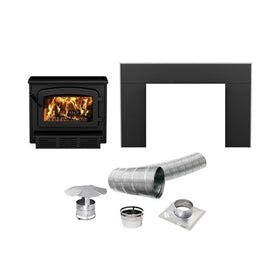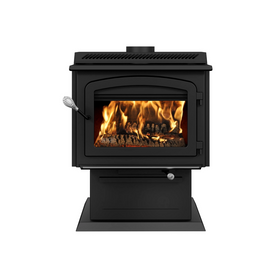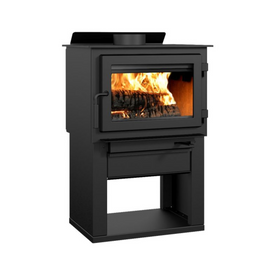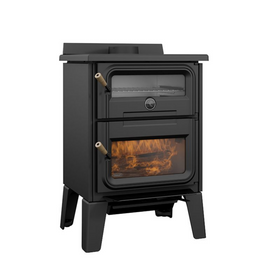
Cast Iron Wood Stoves: A Comprehensive Guide
Last Updated: Feb 26, 2025Colder winter temperatures generally mean that people spend more time inside. Each fall, we miss those late-night barbecues in July and long summer nights of playing outside with the kids. Luckily, one of the hidden joys of winter is curling up beside a crackling wood fire once the outdoor temperatures drop below freezing. The warmth offered by a wood fire is distinctly comforting. This comfort is one reason that 2.5 million households across the country rely on wood as their primary source of heating. An additional 9 million families use wood as a secondary or complementary heat source.
Table of Contents
- Can You Heat a House with a Wood Stove?
- How Do You Measure The Power Output of a Wood Stove?
- The Benefits (and a Few Drawbacks) of Wood Stoves
- Does Heating With Wood Save Money?
- How To Heat With a Cast Iron Wood Stove
- What to Look for in a Quality Cast Iron Wood Stove
- Our Favorite Cast Iron Wood Stoves on the Market
- Bottom Line

The traditional fireplace offers a nostalgic feel to any home. However, a cast iron wood burning stove is a much more efficient way to heat with wood. Cast iron wood stoves can also be added to almost any home while installing a fireplace usually requires expensive remodeling.
Below, we look at some of the benefits (and drawbacks) of cast iron wood stoves. Then, we offer some suggestions for what to look for in a quality wood stove for your home. Finally, we list our favorite manufacturers of residential cast iron wood stoves.

Can You Heat a House with a Wood Stove?
Most wood-burning fireplaces are notoriously inefficient, as the vast majority of heat produced escapes out the chimney. If you have ever sat in front of a fire in a home heated by a fireplace, you probably noticed that your face feels warm while the back of your neck suffers from colder, drafty air. With wood stoves, on the other hand, much more heat is radiated into the home. Woodstove design leads to much less air used for combustion, so fewer drafts subsequently suck the heat out. Newer wood stoves have efficiency ratings of anywhere between 70 and 80 percent. This high efficiency means that the vast majority of heat produced by your stove stays within your home.
Wood stoves are a great addition to the more energy-efficient home construction methods of today. They can also be adapted to work with other green home technologies. Passive homes incorporate high-quality insulation, passive solar heating strategies, and a super-tight home envelope. They require much less heat to begin with and efficiently maintain any heat produced inside the walls. Homes with a ducted furnace or heat pump can also be connected to a cast iron wood stove. This connection will enable the wood fire heat to be spread around your home and regulate the amount of heat you want to send to each area of your home.
How Do You Measure The Power Output of a Wood Stove?
Wood stoves are usually measured in terms of the amount of BTUs they produce. In many cases, the stove manufacturer will label their stove based on the number of square feet it can heat. In general, you need about 3,000 BTUs of heat to warm every 100 square feet of interior living area. So, a 1,500 square foot home would want to source a cast iron wood stove that produced 45,000 BTUs of heat. With the proper sizing and energy-efficient home construction, cast iron wood stoves can effectively heat homes even in harsh winter climates.

The Benefits (and a Few Drawbacks) of Wood Stoves
Cast Iron Wood Stove Durability
Whereas HVAC units generally have a lifespan of anywhere between 15 and 25 years, a quality cast iron wood stove will be a one-time investment that will last a lifetime. Not only are these heating units extremely durable, but maintenance is simple. Generally, homeowners need to clean out the ash, apply some grease once a year to avoid rust, and other simple DIY tasks.
Wood: Renewable Fuel
Cast iron wood stoves also heat your home with a renewable and sustainable resource. There is still debate about whether firewood is an entirely carbon-neutral fuel source. But, it is undoubtedly true that trees absorb vast amounts of carbon during their lifetime, thus offsetting much of the released carbon emissions once burnt. In terms of the resilient home, people who live in rural or suburban situations might be able to grow their own fuel source on their land. Even a small grove of alder or black locust trees will give your home a fast-growing, high BTU source of heat that can often be harvested in as little as 10-12 years.
Does Heating With Wood Save Money?
Cast iron wood stoves can significantly reduce your yearly heating costs. Even homes in colder regions such as the northern US or Canada can often heat their home with only 3-4 cords of firewood each year. If you purchase this much firewood, you can expect to pay around $120-$180 per year per cord. In contrast, average annual heating costs are anywhere between $360 and $720. In areas like Minnesota, the average monthly heating bill can easily be between $200 and $400.
How To Heat With a Cast Iron Wood Stove
On the downside, learning to operate a cast iron wood stove properly can be a challenge. Unlike homes with HVAC units, heating your home with firewood and a cast iron wood stove takes a bit of practice and knowledge. You can't simply turn up your thermostat on a cold morning or trusting your programmable thermostat to have your home at a comfortable temperature when you return from work. A cast iron wood stove requires a basic knowledge of the best practices for burning firewood and the dedication and responsibility to check your stove every 4-8 hours to ensure that it has enough fuel.

What to Look for in a Quality Cast Iron Wood Stove
Are you ready to purchase and install a cast iron wood stove in your home to function as either the primary or secondary heat source for your house? If so, here are a few considerations to keep in mind.
The Right Size
Look for a stove designed for the square footage of your home. If the stove you are looking to purchase only comes labeled by the BTUs it produces, remember that you will need about 3,000 BTUs for every 100 square feet you need to heat.
Catalytic Converters
Stoves that include a catalytic converter will ignite gasses at lower temperatures. This will not only increase the efficiency of your stove by up to 25 percent, but it will also decrease the emissions associated with your stove.
Efficiency
The best-cast iron wood stoves receive efficiency ratings of over 85 percent. Anything over 80 percent is a good choice, though 75 percent efficiency is still a significant improvement over a traditional fireplace.
EPA Emission Rate
Generally, the more efficient your stove, the lower the emission rate will be, and the less polluting your stove will be. While some stoves can achieve emission ratings below 2.0 grams/hour, anything under 3.0 grams/hour is acceptable. According to the EPA, all cast iron wood stoves must be certified to not discharge gases with particulate matter higher than a weighted average of 4.5 g/hr. Many municipalities, like Montreal, are moving over to a 2.5 g/hr maximum.
Purpose of The Stove
The best cast iron wood stove for your home will depend on how you plan to use it. If you want to hook up your stove to a radiator, boiler, or underfloor heating element, you need to make sure that the stove you purchase allows for that function. Some woodstoves are multifunctional. They can be used for cooking and even for supplying your home with a hot water supply.
Our Favorite Cast Iron Wood Stoves on the Market
There are several different models of cast iron wood stoves on the market today. Below, we look at three of our favorite manufacturers.

Vermont Castings
The use of wood stoves is growing extremely fast in the Northeastern part of the country, and Vermont Castings is one of the leading manufacturers. They offer several models and sizes of wood stoves, both with and without catalytic converters. A unique aspect of these stoves is that they are designed to be loaded from the top, making it easier to stack and maintain a long-burning fire. In addition, their thermostatically controlled combustion chamber has a built-in thermostat that requires no electricity and automatically adjusts the air needed for combustion. The Encore Flexburn wood-burning stove allows you to achieve a 15% higher efficiency on low burns when burning with the catalyst converter. With the catalytic converter in use, the emissions associated with this wood stove are only 1.1 grams/hour (1.6 grams/hour without the converter in operation). This stove offers 47,000 BTUs/hour at maximum output and can heat homes anywhere between 900 and 2,300 square feet in size.
Tobias Roberts
Tobias runs an agroecology farm and a natural building collective in the mountains of El Salvador. He specializes in earthen construction methods and uses permaculture design methods to integrate structures into the sustainability of the landscape.












